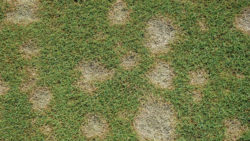As we near the end of August, many areas are seeing the effects of summer weather conditions on the appearance of turf. After nearly three decades in the industry, a couple of things come to mind:
- There will always be an ebb and flow of environmental conditions that have a range of positive and negative impacts on the appearance of turf.
- The issues that are prevalent this year will most likely not be an issue next year for reasons noted above.

This summer, a variety of diseases have plagued our turf causing a “crater effect” on its above-ground appearance. The good news is that while the outward signs are less than desirable, the long-term effects will be minimal.
Soon, we will begin work on fall aerations and seedings. This is the perfect time to “purge” summer sins from your turf. Focal Pointe works closely with several suppliers who provide us with the newest turf cultivars that are best adapted to this region and are best able to fight the multitude of pathogens that plague our turf. Adding these to your existing turf will lessen the detrimental effects of the summer diseases and insects.
The options and products that we provide for our landscape clients produce the year-round appearance that they desire, creating value and strengthening long-term relationships. Although cheaper products exist, using a lower-priced option would be like choosing a flip phone over an iPhone X. Each can make a phone call, which is arguably what a phone is for, but the iPhone provides a wider range of uses and operational features. The same principles apply to using new varieties of turf cultivars over the older, less-effective varieties that are out there.
Seed technology has come a long way, and there are excellent choices for many varieties including Kentucky bluegrass, fine fescue, and ryegrass. Each has its own distinct advantages and uses:
- Kentucky bluegrass, known for its excellent color, density, and texture has an advantage over other cool-season grasses with its high wear tolerance.
- Fine fescue grasses are known for their exceptional shade and cold tolerance. However, they typically have very narrow blades and are not ideal for high-traffic areas.
- Ryegrass, with its high wear tolerance, is often combined with Kentucky bluegrass to provide a durable surface for athletic playing fields.
Because different varieties of grass have varying advantages and disadvantages, turf growers often recommend using blends and mixtures. A blend of grasses is the combination of two or more cultivars of the same species, such as an all tall fescue blend. A mixture is a combination of two or more species of grass, such as a sun and shade mixture of perennial ryegrass, fine fescue, and bluegrass. Using blends and mixtures allows turf to self-adjust based on the environment. The right seed will establish itself in the right place, naturally. For example, using a mixture with perennial rye and a fine fescue would result in the fine fescue thriving in the shade, while the perennial ryegrass flourishes in the high-traffic areas.
While the heat of summer continues to beat down on us, fall is right on our doorstep. Contact Focal Pointe for your seeding needs and we will be happy to accommodate your request with the best blends designed for use in this area.
